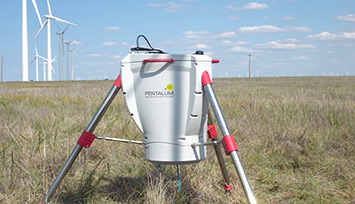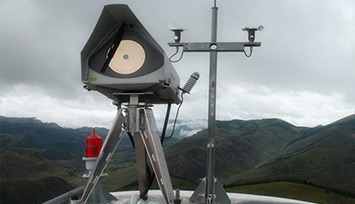The revolutionary wind-measuring SpiDAR is co-developed by teams from Pentalum Technologies and Primanex Corp since 2010 with the purpose of solving normally too low acceptance of LIDARs in wind power and meteorology applications simply because of being too much expensive. SpiDAR is the only one commercially available LIDAR around the world that is not based on Doppler technology, elegantly gets rid of the multiple factors contributing to the expensiveness of regular Doppler-based LIDAR meanwhile achieves compatible wind-measuring performances and competing advantageous edges.
SpiDAR is based on non-coherent direct detection technology, which samples the atmospheric aerosols with laser pulses whose reflected intensity alone is received and sampled in time. The sampled time series represents the aerosol density in the line of sight of the transmitted pulse. By attaining aerosol map snapshots in different locations, at different times, and tracking the aerosol structures, one is able to extract the wind velocity and direction. And, SpiDAR very uniquely employs hi-speed laser scanning engine that does not involve any moving parts, and shares one single laser in a time-division multiplexing (TDM) manner to form multiple laser beams in the space at a very fast scanning speed. Hence, there is not only no concern for SpiDAR on the lifetime due to mechanical fatigue, but also gains drastic advantage on laser scanning speed over conventional mechanical laser scanning techniques.
interferometer or Fabry-Perot etalon to translate light intensity information into the frequency and phase infos. Likewise, SpiDAR has much higher tolerances to the aberration and /or wavefront distortion compared against coherent systems. All these sum up to SpiDAR’s dramatic cost advantage from design point of view, and make SpiDAR much more simpler, more stable, and less vulnerable to hostile environment.
SpiDAR is also well known to have a much smaller laser scanning cone angle compared with the Doppler-based coherent systems. The Doppler systems measure the Doppler freq-shift along the line of sight of laser, and extract the wind speed from the Doppler shift. In other words, Doppler systems won’t be able to measure the horizontal wind speed if the laser is launched vertically; instead, laser must be launched with a moderate angle to the vertical axis so that horizontally moving aerosols can shadow an observable Doppler shift along the laser line. For Doppler-based coherent systems, such angle can be as high as 15-degree (half-angle) or even higher. Hence in reality, Doppler systems are measuring wind by spatially averaging across the laser scanning cone volume. The larger the cone angle, the less likely is for Doppler system being able to represent local wind, which is especially a big concern in complex mountainous terrain. Furthermore, a large laser scanning cone angle makes the LIDAR much easier to be blocked or interfered by surrounding mountain peaks, trees and buildings especially in complex terrain. Hence usually the field installation of Doppler system requires a sufficient clearance volume. However, SpiDAR is more appropriate to work in such complex terrain simply because it is using such a small cone angle as 5-degree (half-angle) only.
Ever since its volume production in year of 2012, SpiDAR has been deployed at over 200 locations across over 20 countries globally, including over 20 locations in China. The world wide deployments geographically cover Europe, Asia, North America, South America and Oceania, and meteorologically cover the deep cold and very hot areas. The longest continuous operation of SpiDAR is already beyond 5 years. SpiDAR has been tested and verified by a series of well-known agencies such as GL Garrad Hassan, ECN, ECOFYS, NREL, BBB, CRES and DNV GL etc.
 |
Ground-based SpiDAR Ground-based SpiDAR employs revolutionary non-coherent direct detection technique, and high-speed laser scanning engine that does not involv... |
 |
Nacelle-based SpiDAR The SpiDAR wind sensor for Wind Turbine Control is specifically designed to provide accurate and timely data of the wind vector ahead of the... |